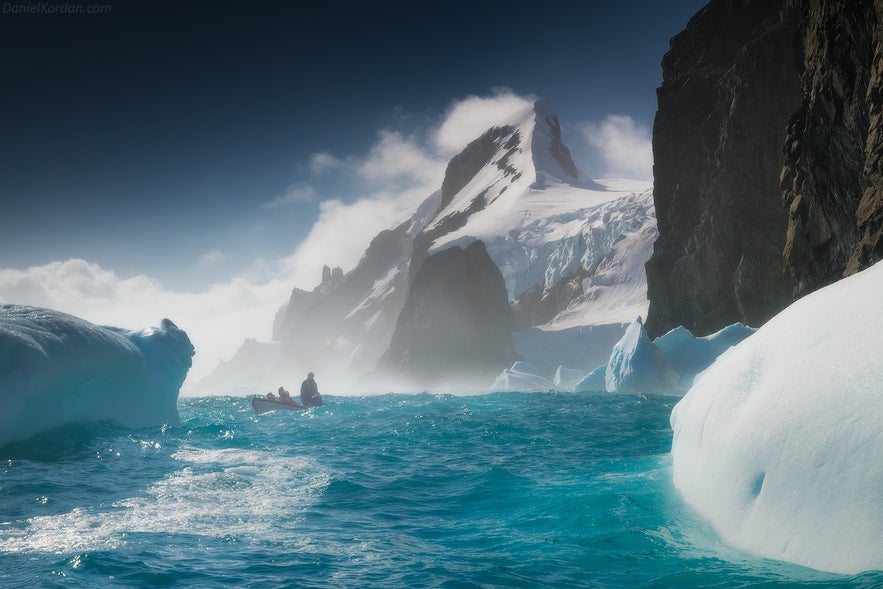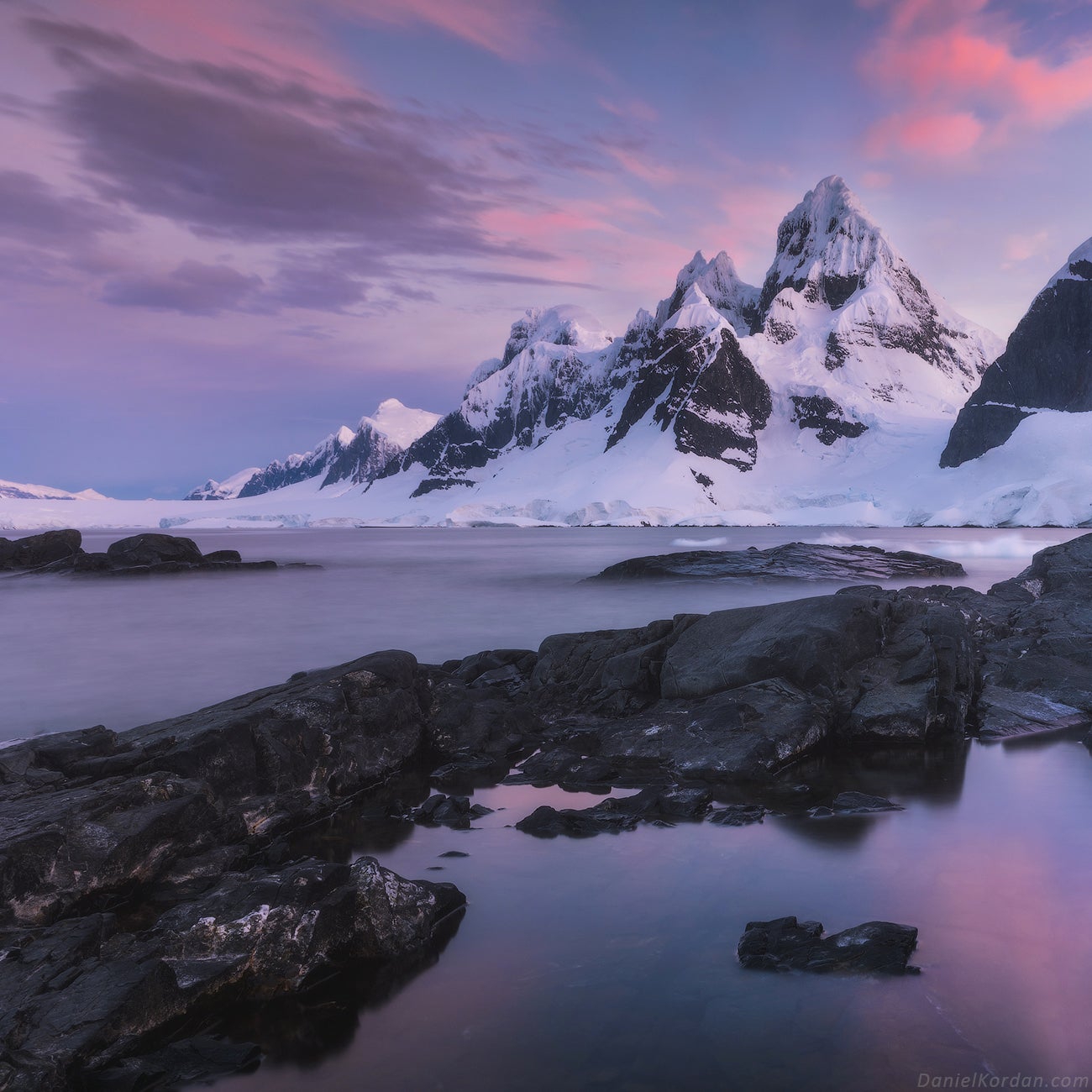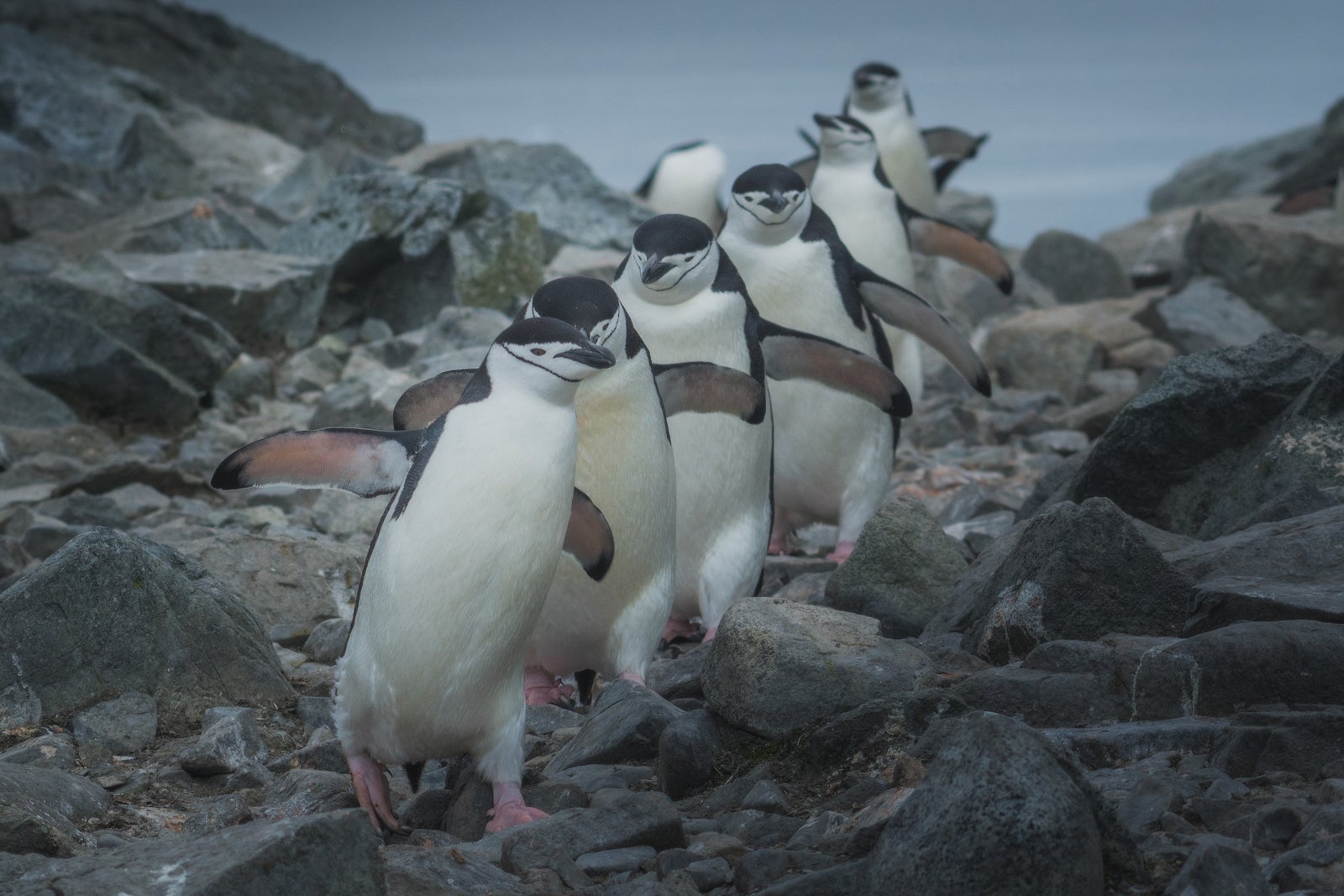
What is the weather like in Antarctica? How is the continent affected by climate change? Will the Antarctic weather affect your holiday here? What impediments can it pose to photographers on a workshop, and how can they be overcome? Continue reading for the ultimate guide to climate and weather in Antarctica.
- Check out these articles on Photography in Antarctica
- See these 25 Useful Tips to Improve Your Landscape Photography
 Antarctica is a desert in spite of its freezing temperatures. Photo by: 'Daniel Kordan'.
Antarctica is a desert in spite of its freezing temperatures. Photo by: 'Daniel Kordan'.
Antarctica boasts the most inhospitable climate and unpredictable weather of anywhere on earth. Not only is it the world’s coldest continent, but also the windiest and driest, making human habitation here all but impossible - only up to 5,000 people live on the landmass at a time, and none permanently.
The climate and weather of the Antarctic make agriculture, significant infrastructure and communications an insurmountable challenge; humans simply have not evolved to deal with such conditions, and modern technology can only go so far. Even in the animal kingdom, only a few species of seal and some seabirds have the adaptations needed to survive here, and most of those only come on land (or onto the ice) in summer.
 An Adelie penguin on a still summer's day in Antarctica. Photo by: 'Daniel Kordan'.
An Adelie penguin on a still summer's day in Antarctica. Photo by: 'Daniel Kordan'.
In spite of the brutality of Antarctica’s extreme weather, however, the continent has an incredible appeal to adventurers across the world, particularly photographers. In fact, much of its allure is due to the climate. Its gleaming landscapes of endless white snow, coastline cluttered with icebergs, gargantuan glaciers and dramatic weather events make the Antarctic one of the most unique and spectacular places on the globe.
Travel to Antarctica is made possible by the fact that the summers are far less brutal than the winters, and the many research centres dotted around (and satellites looking upon) the continent keep a close eye on the weather. Cruise ships departing from the world’s southernmost ports flock here, providing a glimpse of this magnificent land to thousands of visitors a year; some trips even provide opportunities to explore the land.
 Antarctica is a bright land throughout summer. Photo by: 'Daniel Kordan'.
Antarctica is a bright land throughout summer. Photo by: 'Daniel Kordan'.
The fact that Antarctica is so spectacular, remote and little-explored have made particularly photography workshops sought after experiences, for novices and professionals alike. In spite of these tours spending many hours exposed to the Antarctic weather, with trips across the seas in a tiny zodiac and across the land on foot, they are led by regional experts and a perfectly safe way to intimately experience the continent.
Whether or not you are planning a trip to Antarctica, its climate and weather are phenomena that make this inhospitable land a source of fascination, fear and worldwide intrigue.
Statistics on Climate and Weather in Antarctica
 Storm clouds close in on an Antarctic landscape. Photo by: 'Daniel Kordan'.
Storm clouds close in on an Antarctic landscape. Photo by: 'Daniel Kordan'.
Antarctica is the continent surrounding the South Pole, and as such, is one of the two coldest regions of the earth. It is, however, far colder than the Arctic, due to its elevation, the fact it is surrounded by sea and not land, the world’s wind patterns, and the gigantic ice sheet that sits atop it.
An incredible 90% of the world’s ice and over 70% of its freshwater is located on the Antarctic continent. It’s largest ice-sheet is eight times larger than that which covers Greenland, the largest ice-sheet in the Northern Hemisphere. 75% of its coastline is ice shelf, and only on its surrounding islands and on the Antarctic Peninsula will you be able to walk upon rocks and earth, rather than a frozen wasteland.
 The sun never sets in Antarctica in summer. Photo by: 'Daniel Kordan'.
The sun never sets in Antarctica in summer. Photo by: 'Daniel Kordan'.
Due to its polar position, Antarctica experiences the ‘Midnight Sun’ throughout summer - where the sun does not set - and endless nights in winter. Throughout the pitch-black months of June and July, the weather is at its most extreme; on July 21st 1983, for example, the lowest temperatures ever recorded on earth were measured here, at −89.2 °C.
Though such cases are rare, the yearly average temperature of Antarctica’s interior is still an unimaginable -55 °C. Even its warmest regions - the coasts - average at -10 °C. Throughout the summer, these areas hover around freezing, with the highest ever temperature recorded at 17.5 °C.
In spite of its sub-zero conditions, Antarctica is largely considered a desert; on average, it receives just 166 millimetres of precipitation a year, notably shy of the 250 millimetres required to qualify. It should be noted, however, that the Antarctic Peninsula, which most trips (including the aforementioned photo tours) focus on, is not a desert. It can receive up to 630 millimetres of precipitant a year, which is comparable to London.
Climate Change in Antarctica
 Coastal Antarctica is under threat from climate change. Photo by: 'Daniel Kordan'.
Coastal Antarctica is under threat from climate change. Photo by: 'Daniel Kordan'.
As a continent covered in a massive ice sheet, Antarctica is, of course, vulnerable to climate change. While natural changes in the climate have greatly affected the Antarctic over millions of years (being free from ice several times), the accelerated rate of climate change we are currently experiencing is having a significant effect.
Much of this has been well publicised, such as with the breaking up on the Larsen ice shelf and the potential disintegration of the 8,000-year-old George VI ice shelf. The British Antarctic Survey stated in 2009 that global warming would significantly impact much of the continent, with rapid ice loss in some areas contributing up to a 1.6-metre rise in global sea levels. They predicted that over the century, temperatures would rise three degrees on the continent.
- See also: South Greenland Photography Tour
While this is calamitous and worrying, it should be noted that scientific consensus is that the situation across most of Antarctica is far less dire than across the Arctic. The reason for this is that the vast majority of the continent is simply far too cold to be affected by a three degree increase. Furthermore, the white ice that covers almost the entirety of the land is an excellent reflector of heat, whereas the Arctic has far more areas of exposed rock and water, which traps it.
If all of the ice on Antarctica melted, sea levels could rise sixty metres, but even those with the bleakest outlooks concede that this is unlikely to happen for many centuries.
Antarctic Weather and Photographers
 Antarctica is a prime destination for landscape and wildlife photographers. Photo by: 'Daniel Kordan'.
Antarctica is a prime destination for landscape and wildlife photographers. Photo by: 'Daniel Kordan'.
Before taking any trip to Antarctica, its climate and weather are obviously things you will need to consider. When booking most trips, you will often be sent a list with the equipment you will need to prepare for the conditions, namely protective clothing for the harsh winds and sub-zero temperatures.
Those taking a trip focused on photography, however, have far more to consider than simply how to stay warm.
The first main question for photographers is likely to be how to best access such an inhospitable, distant continent; the answer is undoubtedly photography workshops. For example, Daniel Kordan’s Antarctic workshops take you from Chile’s southernmost city, Punta Arenas, on an incredible 11-day journey to the Antarctic landmass aboard the Greg Mortimer, a state-of-the-art ship designed for polar exploration.
 A schooner is a comfortable, modern ship designed for Antarctic waters. Photo by: 'Daniel Kordan'.
A schooner is a comfortable, modern ship designed for Antarctic waters. Photo by: 'Daniel Kordan'.
The journey includes multiple zodiac trips to the islands and Antarctic Peninsula for incredible wildlife and landscape photography opportunities that will vastly improve your portfolio. You will be provided with food and refreshments throughout, as well as cabin service and equipment for your on-shore explorations.
Daniel Kordan himself is an award-winning photographer and accomplished photoguide, who will be on-site each shoot to help you with your technique and available on the ship for lectures and seminars on post-production. You will also be accompanied by an expert Antarctic expedition team, who will provide no end of help when it comes to learning about the continents weather, climate, wildlife and landscapes.
 A schooner sails easily through choppy Antarctic waters. Photo by: 'Daniel Kordan'.
A schooner sails easily through choppy Antarctic waters. Photo by: 'Daniel Kordan'.
The second main concern of any passionate photographer is what impact the weather will have on their camera equipment.
While the vast majority of decent cameras will be unaffected by the freezing but not excessive temperatures of the coastline, the same cannot be said for their batteries; the cold can drain their life incredibly quickly. It is essential to bring fully charged spares with you (with charging ports available on the ship), and if possible, an external battery pack so that you can keep the batteries insulated in a pocket.
Photographers in Antarctica will want an array of lenses for their trips; wide-angle lenses will allow you to take in the magnificent landscapes, telescopic lenses will let you capture the details of the wildlife, and you may want a range of others based on the images you want to take.
- See also: The Best Lenses for Wildlife Photography
 Sea lions wrestle on Antarctic ice. Photo by: 'Daniel Kordan'.
Sea lions wrestle on Antarctic ice. Photo by: 'Daniel Kordan'.
Due to the climate and weather of Antarctica, however, you must remember to travel as light as you can. The cold ensures that you’ll almost always be in cumbersome clothing; the ice makes the terrain difficult to walk across; and the weather can change quickly, meaning you may need to make a swift return to your ship. As such, taking every specialist camera lens and accessory you have will not only make your photography more difficult and trip less enjoyable, but it could endanger your safety.
Tripods can be seen in a somewhat similar vein; if you have one that is little burden, it should be no trouble, but heavier ones will be unnecessary. It should be noted that their use is limited anyway, as the bright sunshine of the Antarctic summers will provide by far enough exposure for your shots (too much, if anything). Furthermore, the continent’s terrain is very uneven, making it quite difficult to get the horizon level and somewhat nullifying its use.
Bringing a plastic case is recommended for waterproofing. It does rain in coastal Antarctica during summer, so you’ll want to protect your camera. Furthermore, when on the zodiacs travelling to and from the continent, you will likely want to take some shots of seabirds overhead or the landscapes across the icy seas without worrying about the spray.
 A schooner sails along the Antarctic ice shelf. Photo by: 'Daniel Kordan'.
A schooner sails along the Antarctic ice shelf. Photo by: 'Daniel Kordan'.
Sunburn is, surprisingly, an issue when on land; the sun reflects fiercely off of the ice, increasing your exposure to UV Rays. Though the vast majority of your body will be wrapped up for warmth, your face and hands may be exposed for lengths of time when shooting, so be sure to lotion up. Furthermore, temperatures of over ten degrees are not at all unheard of, so don’t forget to apply more if you take off any layers.
A final note regarding the weather and climate of Antarctica and photography is the fact that even in summer, it can be fierce and unpredictable. Workshops will only send people out on the zodiacs if a safe trip can be assured, so trips may be postponed, shortened or even cancelled if a storm appears to be moving in or winds become too strong.
- See also: Daniel Kordan Photography Workshops
The climate and weather of Antarctica have made it the most inhospitable land on earth, and yet the dramatic beauty that they bring have entranced people from all over. Those travelling to the southernmost continent should be knowledgeable of the extreme natural forces at work here, so they can safely marvel at the spectacular world such conditions have created.












